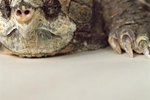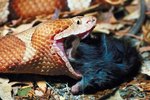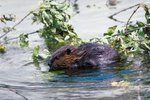
The water moccasin (Agkistrodon piscivorus) is a type of venomous snake that resides in the United States only. These thick and sturdy reptiles are also commonly known as "cottonmouths" -- a nod to the conspicuous whiteness of the insides of their mouths. Water moccasins, for the most part, are busiest during the nighttime.
Physical Appearance
These semi-aquatic creatures are usually between 2 and 4 feet long. Male water moccasins are bigger than the females. Both genders appear in numerous different colors and color schemes, including black, brown and yellowish-brown. Water moccasins have dark and wide banding on their bodies -- some more prominent than others. Their heads are shaped similarly to triangles.
Natural Habitat
Water moccasins are prevalent in the southern and Midwestern parts of the United States, from Georgia to Illinois. These independent snakes are abundant in freshwater settings and are a fixture in many lakes, ponds, wetlands, sloughs, floodplains, creeks, bayous, swamps, ditches, marshes and bayheads within their geographic region. Water moccasins also often camp out on agricultural sites close to slow streams or marshes, since they prefer damp environments.
Breeding
Water moccasins are capable of reproducing at any time, although the most reproductive activity takes place in the spring, in both April and May. The females are pregnant for roughly five months, with birthing intervals of around two to three years. They usually bear between five and nine offspring at once. Since these reptiles are oviviparous, their youngsters usually hatch while still inside of their mothers' bodies.
Diet
Water moccasins are flesh eaters, and the bulk of their menu consists of fish and mammals. These snakes routinely consume birds, rotting carcass remains, bugs, eggs, amphibians and other reptiles -- think juvenile alligators. Water moccasins occasionally even dine on the smaller members of their own species -- in true cannibalistic style. They are opportunistic when it comes to food, and therefore are in no way selective about mealtime options.
White Mouths
These pit vipers broadly open up their mouths when they're feeling protective and frightened. If these snakes are in defensive mode over a potential predator, they attempt to ward the other party away by showing off their white mouths. Although water moccasins are venomous, they do not usually bite unless someone steps over their bodies or tries to hold them. Apart from attempts to drive predators off with their mouth displays, they also possess scent glands that emit aggressively unpleasant odors. Some of the species' major predator threats are people, birds of prey, raccoons, house cats and snapping turtles.
References
- The IUCN Red List of Threatened Species: Agkistrodon pPiscivorus
- University of Michigan Animal Diversity Web: Agkistrodon Piscivorus
- Savannah River Ecology Laboratory: Cottonmouth/Water Moccasin
- USGS: Agkistrodon Piscivorus
- Virginia Department of Game and Inland Fisheries: Eastern Cottonmouth
- Illinois Natural History Survey: Agkistrodon Piscivorus
- Smithsonian National Zoological Park: Cottonmouth
Photo Credits
-
Jupiterimages/Photos.com/Getty Images




